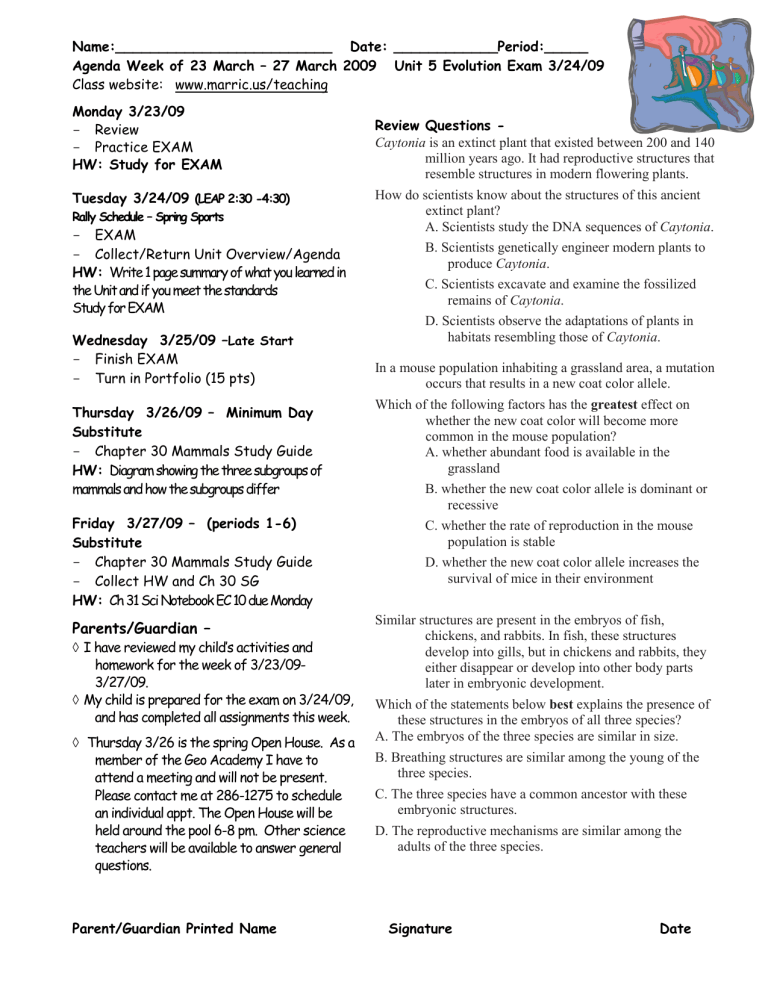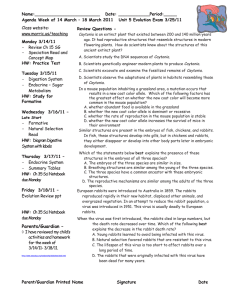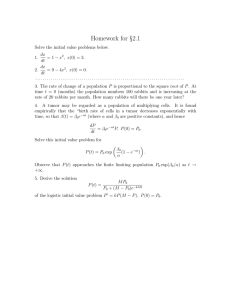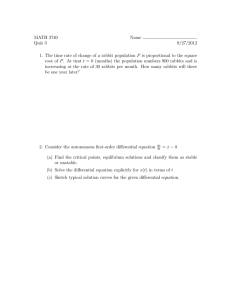Name:_________________________ Date: ____________Period:_____
advertisement

Name:_________________________ Date: ____________Period:_____ Agenda Week of 23 March – 27 March 2009 Unit 5 Evolution Exam 3/24/09 Class website: www.marric.us/teaching Monday 3/23/09 - Review - Practice EXAM HW: Study for EXAM Tuesday 3/24/09 (LEAP 2:30 -4:30) Rally Schedule – Spring Sports - EXAM - Collect/Return Unit Overview/Agenda HW: Write 1 page summary of what you learned in the Unit and if you meet the standards Study for EXAM Wednesday 3/25/09 –Late Start - Finish EXAM - Turn in Portfolio (15 pts) Thursday 3/26/09 – Minimum Day Substitute - Chapter 30 Mammals Study Guide HW: Diagram showing the three subgroups of mammals and how the subgroups differ Friday 3/27/09 – (periods 1-6) Substitute - Chapter 30 Mammals Study Guide - Collect HW and Ch 30 SG HW: Ch 31 Sci Notebook EC 10 due Monday Parents/Guardian – I have reviewed my child’s activities and homework for the week of 3/23/093/27/09. My child is prepared for the exam on 3/24/09, and has completed all assignments this week. Thursday 3/26 is the spring Open House. As a member of the Geo Academy I have to attend a meeting and will not be present. Please contact me at 286-1275 to schedule an individual appt. The Open House will be held around the pool 6-8 pm. Other science teachers will be available to answer general questions. Parent/Guardian Printed Name Review Questions Caytonia is an extinct plant that existed between 200 and 140 million years ago. It had reproductive structures that resemble structures in modern flowering plants. How do scientists know about the structures of this ancient extinct plant? A. Scientists study the DNA sequences of Caytonia. B. Scientists genetically engineer modern plants to produce Caytonia. C. Scientists excavate and examine the fossilized remains of Caytonia. D. Scientists observe the adaptations of plants in habitats resembling those of Caytonia. In a mouse population inhabiting a grassland area, a mutation occurs that results in a new coat color allele. Which of the following factors has the greatest effect on whether the new coat color will become more common in the mouse population? A. whether abundant food is available in the grassland B. whether the new coat color allele is dominant or recessive C. whether the rate of reproduction in the mouse population is stable D. whether the new coat color allele increases the survival of mice in their environment Similar structures are present in the embryos of fish, chickens, and rabbits. In fish, these structures develop into gills, but in chickens and rabbits, they either disappear or develop into other body parts later in embryonic development. Which of the statements below best explains the presence of these structures in the embryos of all three species? A. The embryos of the three species are similar in size. B. Breathing structures are similar among the young of the three species. C. The three species have a common ancestor with these embryonic structures. D. The reproductive mechanisms are similar among the adults of the three species. Signature Date Bell Ringers: Week of 23 Mar – 27 Mar 2009 Monday – The illustrations below show a South American finch and some of the species of finches found on the Galápagos Islands. The map shows the relationship of the Galápagos Islands to the west coast of South America. There are 13 species of finches found on the Galápagos Islands. These finches have a wide variety of food sources and beak shapes. There is one genetically similar species of finch found on the South American mainland. This finch eats small seeds. Use the map and the bird illustrations to identify and explain two ways that these finches provide evidence that supports the theory of evolution. European rabbits were introduced to Australia in 1859. The rabbits reproduced rapidly in their new habitat, displaced other animals, and overgrazed vegetation. In an attempt to reduce the rabbit population, a virus was introduced in 1951. This virus is usually deadly to European rabbits. When the virus was first introduced, the rabbits died in large numbers, but the death rate decreased over time. Which of the following best explains the decrease in the rabbit death rate? A. Young rabbits learned to avoid being infected with this virus. B. Natural selection favored rabbits that are resistant to this virus. C. The lifespan of this virus is too short to affect rabbits over a long period of time. D. The rabbits that were originally infected with this virus have been dead for many years. Tuesday –EXAM Wednesday – EXAM Thursday - Which of the following is a main function of the cell wall? A. to store carbohydrates for later use C. to package proteins for export B. to give the cell a rigid structure D. to carry out photosynthesis Friday - Which of the following best describes the formation of a zygote? A. A sperm cell nucleus and an egg cell nucleus fuse. B. A cell’s DNA replication and mitosis are accelerated. C. A succession of cell divisions produces a solid mass of cells. D. A cell with 46 chromosomes divides to form cells with 23 chromosomes each.



